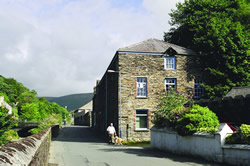The nearby entrance leads to the washing floors which Robert Casement designed in 1848.
![]() Exit the bottom of the washing floors and follow the river onto Glen Road where it
Exit the bottom of the washing floors and follow the river onto Glen Road where it 
meets the Glen Roy tributary. On the opposite side is a church hall, formerly the village infant school. This operated in conjunction with the National School which was on the hillside above the Woollen Mills.
The mills started life as water powered corn mills but were acquired by Egbert Rydings a silk weaver from Clitheroe in Lancashire and the St. George’s Guild founded by John Ruskin, and reopened as such in 1881.
The mills operated on the principle “from the mountain track to the wearer’s back” – i.e. you should be able to have a suit made out of the wool you supplied to the mill. Use of steam powered machinery was not allowed but was briefly introduced in the 1940s and 1950s, until the mills returned to hand production as today.
The Laxey tartan is one of its most popular products.

